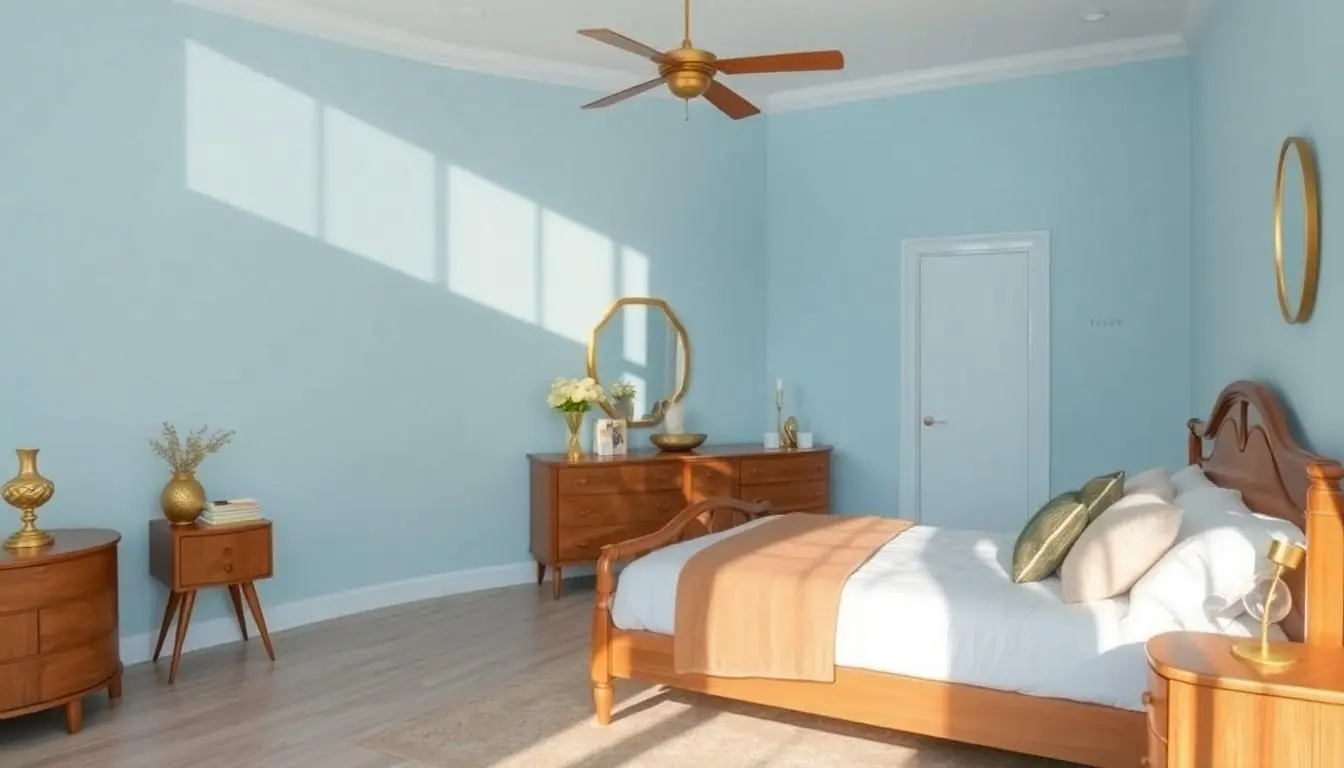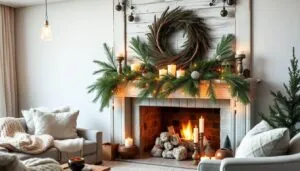Choosing the perfect blue paint color for a bedroom might feel like searching for a needle in a haystack—if that haystack were filled with a million shades of blue. From serene sky tones to deep navy, blue can transform a room into a calming oasis or a vibrant retreat. It’s like giving your walls a refreshing drink of water, and who wouldn’t want that?
Table of Contents
TogglePopular Blue Paint Colors for Bedrooms
Selecting a blue paint color for a bedroom offers a variety of options. The following shades provide distinct atmospheres.
Light Blue Shades
Light blue shades create a fresh and airy feeling. Soft tones like sky blue evoke serenity, making them perfect for relaxation. Colors such as powder blue add a touch of elegance and pair well with white accents. Additionally, robin’s egg blue brings a playful yet soothing vibe ideal for morning light.
Dark Blue Shades
Dark blue shades introduce depth and drama to a bedroom. Midnight blue provides a cozy ambiance, fostering warmth on chilly nights. Other options like cobalt blue provide a vibrant contrast, especially against lighter furniture. These rich colors can make a striking statement when used on accent walls or as part of a color theme.
Navy Blue Options
Navy blue options offer sophistication and versatility. This deep hue works well with various decor styles, from traditional to modern. Pairing navy with gold or brass accents creates a luxurious look. Furthermore, adding navy as an accent can enhance other colors, highlighting their beauty while maintaining a calm environment.
Choosing the Right Blue Paint Color

Selecting the right blue paint color enhances a bedroom’s atmosphere significantly. Understanding room size and lighting conditions aids in making an informed choice.
Consider Room Size and Lighting
Small rooms benefit from lighter shades of blue, as these colors create an illusion of spaciousness. Bright blues, such as sky blue, reflect light well, brightening corners and enhancing overall brightness. In contrast, larger rooms can accommodate darker blues, like navy or midnight blue, to add depth and coziness. Examining natural light sources also influences the final choice. Rooms with ample sunlight can handle richer tones without feeling overpowering. On the other hand, rooms that receive limited light may require softer, paler shades to avoid a dark, closed-in effect.
Matching Furniture and Decor
Compatibility between furniture and paint color is crucial for achieving a cohesive look. Warm-toned wood furniture pairs beautifully with light blues, creating an inviting atmosphere. Darker blues contrast strikingly with white or light-colored furniture, making pieces stand out. Accent colors in decor, such as cushions or rugs, should harmonize with the chosen blue. For example, adding gold or brass accents enhances the luxurious feel of navy blue. Personal style can also guide choices; coastal themes benefit from turquoise or aqua, while modern designs might favor deep cobalt blues for a bold statement. Balancing these elements ensures a well-designed bedroom that invites relaxation.
Trends in Blue Paint Colors
Current trends highlight the versatility of blue paint colors in bedrooms. Many homeowners gravitate toward soothing palettes that evoke calmness and relaxation.
Modern Blue Palettes
Modern designs often feature soft blues like misty blue and light teal. These lighter shades create airy atmospheres, particularly in spaces with ample natural light. Accent walls in deeper tones, such as slate or navy, offer stylish focal points that add depth. Pairing these hues with white trim brings an updated feel to any bedroom while maintaining a sense of serenity. Layering various textures and materials can enhance the overall look, making blue shades feel fresh and contemporary.
Classic Blue Combinations
Classic combinations remain popular, particularly navy and white. This timeless pairing exudes sophistication and elegance, ideal for creating a refined ambiance. Incorporating warm wood tones further enriches the aesthetic, balancing the coolness of blue. Other complementary colors, such as soft gray and muted pastels, offer a subtle yet stylish contrast. These combinations allow for personalization while adhering to traditional elements, ensuring the bedroom remains inviting and stylish.
Tips for Painting Your Bedroom
Painting a bedroom requires careful planning and execution for optimal results. Prioritize the preparation and application techniques to achieve a professional finish.
Preparing Your Walls
Clean walls ensure optimal paint adhesion. Start by wiping down surfaces to remove dust and grease. Fill in any holes or cracks with spackle or joint compound. Sand the patched areas once dry for a smooth surface. Taping edges and trim will help create clean lines. Use painter’s tape to prevent paint from seeping into unwanted areas. Finally, applying a primer can enhance color vibrancy and coverage, especially for darker shades.
Application Techniques
Choosing the right tools impacts the painting process. Paint rollers work well for large areas, while brushes are ideal for corners and edges. Begin with ceilings, then walls, and finish with trim. Applying paint in even strokes prevents streaks and uneven patches. Start at the top and work down to catch drips. For best results, use multiple thin coats rather than a single thick one. Allow ample drying time between coats to ensure an even finish.
Choosing the right blue paint color for a bedroom can transform the space into a serene retreat or a vibrant haven. With a variety of shades available it’s essential to consider factors like room size lighting and personal style. Lighter tones can create an airy feel in smaller spaces while deeper hues add sophistication and depth to larger rooms.
Incorporating complementary colors and accent pieces enhances the overall design making the bedroom not just a place to sleep but a reflection of individual taste. With careful planning and execution homeowners can achieve a stunning and inviting atmosphere that promotes relaxation and comfort.


